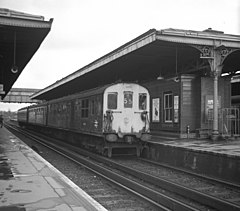British Rail Class 206
| British Rail Class 206 | |
|---|---|

Class 206 3R unit at Guildford, June 1979
|
|
| In service | 1964-early 1990s (But 4 units were disbanded in 1979) |
| Constructed | 1964 |
| Number built | 6 trainsets |
| Formation | DMBS+TSL+DTS |
| Operator(s) | British Rail |
| Specifications | |
| Maximum speed | 75 mph (121 km/h) |
| Weight | 54.1 long tons (55.0 t; 60.6 short tons) |
| Prime mover(s) | English Electric 4SRKT Mark II |
| Power output | 600 shp (450 kW) at 850 rpm |
The British Rail Class 206 or 3R was a type of Diesel-electric multiple unit (DEMU) first created in 1964. They were not 'built' as such but rather re-formed from Class 201 and EPB vehicles for use on Reading-Redhill-Tonbridge (North Downs Line) services. Six three-car sets were created, numbered 1201-1206.
By 1964, the majority of services on the Southern Region of British Railways had been converted to diesel and electric operation. However, steam locomotives continued to operate the entire service on the North Downs Line. New trains for this route could not be justified as passenger numbers were relatively low. Twelve carriages from Class 201 diesel-electric units were available for use following service cuts on the Hastings Line, so a decision was made to combine these vehicles with six redundant driving trailers from 2-EPB electric multiple units (EMU).
Several changes were made to the vehicles before they entered service. The EPB vehicles were fitted with buckeye couplers to allow them to attach to the DEMU vehicles. A three-bay luggage area was created in the former EMU carriages to cope with the high level of mail traffic on the Reading to Tonbridge route, while the engines in the former DEMU vehicles were uprated by 100hp.
The new units were given the numbers 1201-1206, and entered service in January 1965. They were commonly referred to as 'Tadpoles' due to the difference in body profiles between the 201 and EPB stock. Following the adoption of TOPS in the late 1960s, the units were given the Class number 206.
...
Wikipedia
